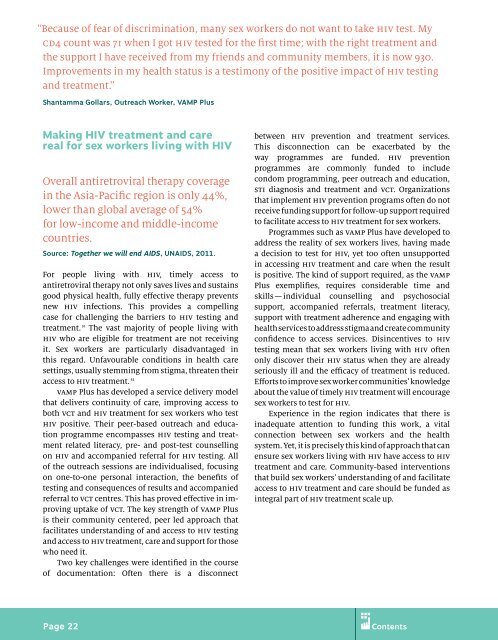The HIV and Sex Work Collection - Joint Programme Monitoring ...
The HIV and Sex Work Collection - Joint Programme Monitoring ...
The HIV and Sex Work Collection - Joint Programme Monitoring ...
Create successful ePaper yourself
Turn your PDF publications into a flip-book with our unique Google optimized e-Paper software.
“Because of fear of discrimination, many sex workers do not want to take <strong>HIV</strong> test. MyCD4 count was 71 when I got <strong>HIV</strong> tested for the first time; with the right treatment <strong>and</strong>the support I have received from my friends <strong>and</strong> community members, it is now 930.Improvements in my health status is a testimony of the positive impact of <strong>HIV</strong> testing<strong>and</strong> treatment.”Shantamma Gollars, Outreach <strong>Work</strong>er, VAMP PlusMaking <strong>HIV</strong> treatment <strong>and</strong> carereal for sex workers living with <strong>HIV</strong>Overall antiretroviral therapy coveragein the Asia-Pacific region is only 44%,lower than global average of 54%for low-income <strong>and</strong> middle-incomecountries.Source: Together we will end AIDS, UNAIDS, 2011.For people living with <strong>HIV</strong>, timely access toantiretroviral therapy not only saves lives <strong>and</strong> sustainsgood physical health, fully effective therapy preventsnew <strong>HIV</strong> infections. This provides a compellingcase for challenging the barriers to <strong>HIV</strong> testing <strong>and</strong>treatment. 51 <strong>The</strong> vast majority of people living with<strong>HIV</strong> who are eligible for treatment are not receivingit. <strong>Sex</strong> workers are particularly disadvantaged inthis regard. Unfavourable conditions in health caresettings, usually stemming from stigma, threaten theiraccess to <strong>HIV</strong> treatment. 52VAMP Plus has developed a service delivery modelthat delivers continuity of care, improving access toboth VCT <strong>and</strong> <strong>HIV</strong> treatment for sex workers who test<strong>HIV</strong> positive. <strong>The</strong>ir peer-based outreach <strong>and</strong> educationprogramme encompasses <strong>HIV</strong> testing <strong>and</strong> treatmentrelated literacy, pre- <strong>and</strong> post-test counsellingon <strong>HIV</strong> <strong>and</strong> accompanied referral for <strong>HIV</strong> testing. Allof the outreach sessions are individualised, focusingon one-to-one personal interaction, the benefits oftesting <strong>and</strong> consequences of results <strong>and</strong> accompaniedreferral to VCT centres. This has proved effective in improvinguptake of VCT. <strong>The</strong> key strength of VAMP Plusis their community centered, peer led approach thatfacilitates underst<strong>and</strong>ing of <strong>and</strong> access to <strong>HIV</strong> testing<strong>and</strong> access to <strong>HIV</strong> treatment, care <strong>and</strong> support for thosewho need it.Two key challenges were identified in the courseof documentation: Often there is a disconnectbetween <strong>HIV</strong> prevention <strong>and</strong> treatment services.This disconnection can be exacerbated by theway programmes are funded. <strong>HIV</strong> preventionprogrammes are commonly funded to includecondom programming, peer outreach <strong>and</strong> education,STI diagnosis <strong>and</strong> treatment <strong>and</strong> VCT. Organizationsthat implement <strong>HIV</strong> prevention programs often do notreceive funding support for follow-up support requiredto facilitate access to <strong>HIV</strong> treatment for sex workers.<strong>Programme</strong>s such as VAMP Plus have developed toaddress the reality of sex workers lives, having madea decision to test for <strong>HIV</strong>, yet too often unsupportedin accessing <strong>HIV</strong> treatment <strong>and</strong> care when the resultis positive. <strong>The</strong> kind of support required, as the VAMPPlus exemplifies, requires considerable time <strong>and</strong>skills — individual counselling <strong>and</strong> psychosocialsupport, accompanied referrals, treatment literacy,support with treatment adherence <strong>and</strong> engaging withhealth services to address stigma <strong>and</strong> create communityconfidence to access services. Disincentives to <strong>HIV</strong>testing mean that sex workers living with <strong>HIV</strong> oftenonly discover their <strong>HIV</strong> status when they are alreadyseriously ill <strong>and</strong> the efficacy of treatment is reduced.Efforts to improve sex worker communities’ knowledgeabout the value of timely <strong>HIV</strong> treatment will encouragesex workers to test for <strong>HIV</strong>.Experience in the region indicates that there isinadequate attention to funding this work, a vitalconnection between sex workers <strong>and</strong> the healthsystem. Yet, it is precisely this kind of approach that canensure sex workers living with <strong>HIV</strong> have access to <strong>HIV</strong>treatment <strong>and</strong> care. Community-based interventionsthat build sex workers’ underst<strong>and</strong>ing of <strong>and</strong> facilitateaccess to <strong>HIV</strong> treatment <strong>and</strong> care should be funded asintegral part of <strong>HIV</strong> treatment scale up.Page 22
















